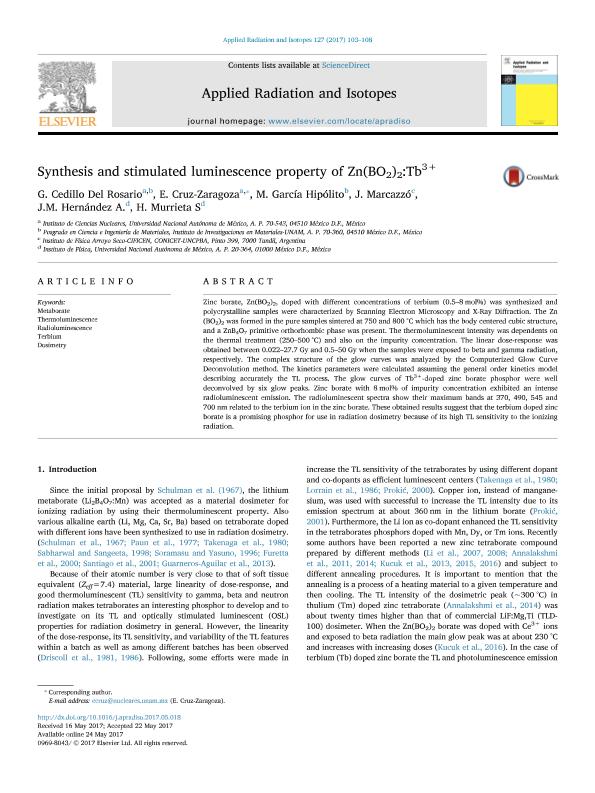Mostrar el registro sencillo del ítem
dc.contributor.author
Del Rosario, G. Cedillo
dc.contributor.author
Cruz Zaragoza, Epifanio

dc.contributor.author
Hipólito, M. García
dc.contributor.author
Marcazzo, Salvador Julian

dc.contributor.author
Hernández A., J. M.
dc.contributor.author
Murrieta S. H.
dc.date.available
2018-09-03T21:51:25Z
dc.date.issued
2017-09
dc.identifier.citation
Del Rosario, G. Cedillo; Cruz Zaragoza, Epifanio; Hipólito, M. García; Marcazzo, Salvador Julian; Hernández A., J. M.; et al.; Synthesis and stimulated luminescence property of Zn(BO2)2:Tb3+; Pergamon-Elsevier Science Ltd; Applied Radiation and Isotopes; 127; 9-2017; 103-108
dc.identifier.issn
0969-8043
dc.identifier.uri
http://hdl.handle.net/11336/58193
dc.description.abstract
Zinc borate, Zn(BO2)2, doped with different concentrations of terbium (0.5–8 mol%) was synthesized and polycrystalline samples were characterized by Scanning Electron Microscopy and X-Ray Diffraction. The Zn(BO2)2 was formed in the pure samples sintered at 750 and 800 °C which has the body centered cubic structure, and a ZnB4O7 primitive orthorhombic phase was present. The thermoluminescent intensity was dependents on the thermal treatment (250–500 °C) and also on the impurity concentration. The linear dose-response was obtained between 0.022–27.7 Gy and 0.5–50 Gy when the samples were exposed to beta and gamma radiation, respectively. The complex structure of the glow curves was analyzed by the Computerized Glow Curve Deconvolution method. The kinetics parameters were calculated assuming the general order kinetics model describing accurately the TL process. The glow curves of Tb3+-doped zinc borate phosphor were well deconvolved by six glow peaks. Zinc borate with 8 mol% of impurity concentration exhibited an intense radioluminescent emission. The radioluminescent spectra show their maximum bands at 370, 490, 545 and 700 nm related to the terbium ion in the zinc borate. These obtained results suggest that the terbium doped zinc borate is a promising phosphor for use in radiation dosimetry because of its high TL sensitivity to the ionizing radiation.
dc.format
application/pdf
dc.language.iso
eng
dc.publisher
Pergamon-Elsevier Science Ltd

dc.rights
info:eu-repo/semantics/openAccess
dc.rights.uri
https://creativecommons.org/licenses/by-nc-sa/2.5/ar/
dc.subject
Dosimetry
dc.subject
Metaborate
dc.subject
Radioluminescence
dc.subject
Terbium
dc.subject
Thermoluminescence
dc.subject.classification
Astronomía

dc.subject.classification
Ciencias Físicas

dc.subject.classification
CIENCIAS NATURALES Y EXACTAS

dc.title
Synthesis and stimulated luminescence property of Zn(BO2)2:Tb3+
dc.type
info:eu-repo/semantics/article
dc.type
info:ar-repo/semantics/artículo
dc.type
info:eu-repo/semantics/publishedVersion
dc.date.updated
2018-09-03T20:00:04Z
dc.journal.volume
127
dc.journal.pagination
103-108
dc.journal.pais
Países Bajos

dc.journal.ciudad
Amsterdam
dc.description.fil
Fil: Del Rosario, G. Cedillo. Universidad Nacional Autónoma de México. Instituto de Ciencias Nucleares; México
dc.description.fil
Fil: Cruz Zaragoza, Epifanio. Universidad Nacional Autónoma de México. Instituto de Ciencias Nucleares; México
dc.description.fil
Fil: Hipólito, M. García. Universidad Nacional Autónoma de México; México
dc.description.fil
Fil: Marcazzo, Salvador Julian. Universidad Nacional del Centro de la Provincia de Buenos Aires. Centro de Investigaciones en Física e Ingeniería del Centro de la Provincia de Buenos Aires. - Consejo Nacional de Investigaciones Científicas y Técnicas. Centro Científico Tecnológico Conicet - Tandil. Centro de Investigaciones en Física e Ingeniería del Centro de la Provincia de Buenos Aires. - Provincia de Buenos Aires. Gobernación. Comisión de Investigaciones Científicas. Centro de Investigaciones en Física e Ingeniería del Centro de la Provincia de Buenos Aires; Argentina
dc.description.fil
Fil: Hernández A., J. M.. Universidad Nacional Autónoma de México; México
dc.description.fil
Fil: Murrieta S. H.. Universidad Nacional Autónoma de México; México
dc.journal.title
Applied Radiation and Isotopes

dc.relation.alternativeid
info:eu-repo/semantics/altIdentifier/url/https://www.sciencedirect.com/science/article/pii/S0969804317306528
dc.relation.alternativeid
info:eu-repo/semantics/altIdentifier/doi/http://dx.doi.org/10.1016/j.apradiso.2017.05.018
Archivos asociados
